| Author |
Topic |
|
|
Ashley
656 Posts
Ashley
MOSCOW
Idaho
USA
|
 Posted - May 23 2018 : 1:58:47 PM Posted - May 23 2018 : 1:58:47 PM


|
When we talk about creating a wild-yeast mother, good organic flour and purified water are at the top of the list of must-haves. Why is water so important to the health of a wild-yeast mother?
We typically think of water as one of the most "pure and natural" substances. This is true, but being a product of nature, water is also home to trace minerals, microbes, and sometimes bacteria. To combat this, various degrees of filtration and/or purification are employed to rid water of potential contaminates. The addition of chlorine to tap water is also common practice. Chlorine in particular can have a negative impact of how your wild-yeast mother performs.
The ultimate goal is to add the best, purest water accessible to you. Due to chlorination, tap water is not a good option for a mother. Well water that has been tested for purity is an option, as well as distilled or purified water. For in-home water distiller and water purifier recommendations, see p. 209 of Wild Bread.
|
Ashley Ogle |
|
|
carolini
9 Posts
Caroline
Winona
Minnesota
USA
|
 Posted - Aug 25 2018 : 8:52:03 PM Posted - Aug 25 2018 : 8:52:03 PM


|
| I thought I read from your book that if you don't have chlorinated water, ie, well water, that you might be able to get away with well water. I have not been, but could use the water filtered from my fridge. Would this be preferable. so for after a week my starter is active but not like Old Faithful! Ideas? |
Caroline M. Howard |
 |
|
|
MaryJane
174 Posts
MaryJane
MOSCOW
Idaho
USA
|
 Posted - Aug 26 2018 : 06:15:36 AM Posted - Aug 26 2018 : 06:15:36 AM


|
| Like I mentioned in my other post, Caroline, your Nana needs more time to mature if you've only been feeding her for a week. Because variables are difficult to troubleshoot, we try to steer beginners away from, well, unknown waters! It's always good to limit the variables when starting out. Eventually you can try your refrigerator water (you'd want to bring it up to room temperature first). |
MaryJane Butters, author of Wild Bread ~ for we were all one family then ~  |
 |
|
|
Ashley
656 Posts
Ashley
MOSCOW
Idaho
USA
|
 Posted - Aug 26 2018 : 10:42:41 AM Posted - Aug 26 2018 : 10:42:41 AM


|
What type of water are you currently using to feed your mother? I’m not sure from your post. Are you on a well or municipal tap water? I you have tap water and it is chlorinated, your fridge filter won’t remove it, so you would still need to find out a way to get water without chlorine. Like MaryJane said, since you are just a week in, your mother needs a little more time until your mother becomes active.
|
Ashley Ogle |
 |
|
|
Back2theroots
10 Posts
Jay
St. Petersburg
Florida
USA
|
 Posted - Apr 23 2019 : 3:27:50 PM Posted - Apr 23 2019 : 3:27:50 PM


|
Hi, my name is Jay and love in Florida. So air conditioning plays a role here possibly.
Is RO (Reverse Osmosis) water a suitable source of water for my counter mother? I know most RO systems acidify the water so its easier to remove all contaminants but not sure how ph plays in with yeasts. It seems to work fine with lacto fermenting of vegetables but since that is mainly the lacto bacilli I wasnt sure if my counter mother was being taken over by them instead of the wild yeast. I just completed 4 weeks and am not yet getting the full rise in 6 to 8 hours. I am using Einka flower from bluebird. But just curious if there is anyone with experience using RO water and having good success. I can try to post some pictures on my next bake day to show more clearly what is going on.
Another question that has been bothering me is if the butter that I brush on the top that was melted has to be room temperature or is it of to brush on while still warm. I use ghee. I figure room temperature is probably best because it might cook the top and prevent rise or make it harder?
Thanks for any input in advance. |
 |
|
|
Ashley
656 Posts
Ashley
MOSCOW
Idaho
USA
|
 Posted - Apr 24 2019 : 09:07:53 AM Posted - Apr 24 2019 : 09:07:53 AM


|
Hi Jay, I think it's possible that the acidification of RO water could cause the balance of lacto bacteria and wild yeast to be off. How much rise are you seeing from your breads? And do your breads have an overly acidic taste? If you're seeing pretty decent rise (even if its not rising to the top edge of the dish in 6–8 hours), and your breads aren't overly sour, there's a chance the wild yeast will balance out given more time.
As for the melted butter (or ghee) brushed onto the tops of loaves, it can go on warm, but I wouldn't put it on there hot. Basically, if it's too hot to touch, it's too hot for your mother.
If you're able to upload a couple pictures of your batter bread that would be great. |
Ashley Ogle |
 |
|
|
Back2theroots
10 Posts
Jay
St. Petersburg
Florida
USA
|
 Posted - Apr 29 2019 : 12:17:47 PM Posted - Apr 29 2019 : 12:17:47 PM


|
Hi Ashley,
Thanks for your prompt reply. So this weekend was now week 6 and here are some
Photos. I have now switched to distilled water for this week to see if it will change things.
This is my mother the morning of bake day:
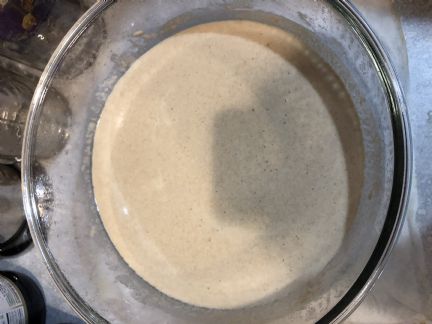
This is the water I switched to for this week:
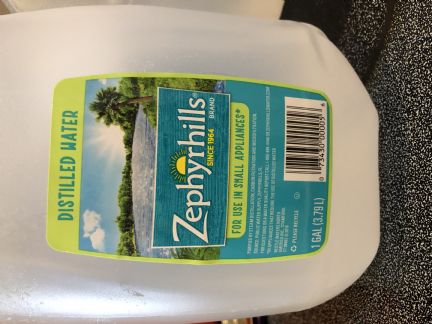
This is the consistency I go for in “softened” cream cheese, not sure if its right, any input to improvement appreciated:

This is filling the pan side view:
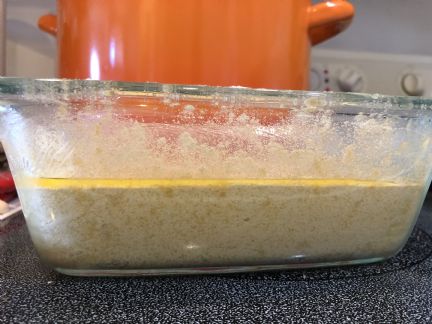
Top view:

Here we have 10 hours later top view, barely any rise although still has air bubbles on the inside:
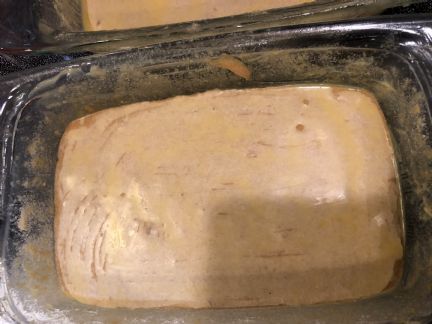
Side view:
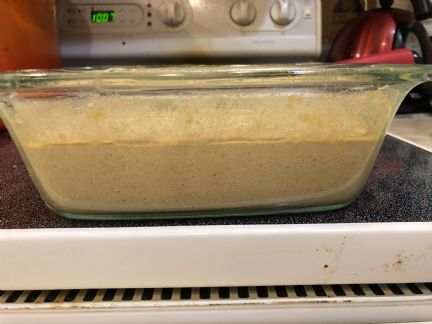
This is the bread baked:
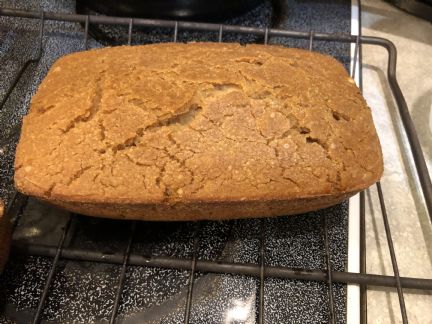
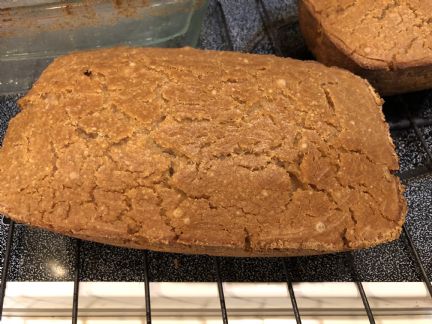
It is sour but I like the flavor so not sure if its too sour or what. But that probably means Im heavy of lacto bacteria if it is too sour, right? So will me switching to the distilled water above balance out over time.
Thank you for your help!
quote:
Originally posted by Ashley
Hi Jay, I think it's possible that the acidification of RO water could cause the balance of lacto bacteria and wild yeast to be off. How much rise are you seeing from your breads? And do your breads have an overly acidic taste? If you're seeing pretty decent rise (even if its not rising to the top edge of the dish in 6–8 hours), and your breads aren't overly sour, there's a chance the wild yeast will balance out given more time.
As for the melted butter (or ghee) brushed onto the tops of loaves, it can go on warm, but I wouldn't put it on there hot. Basically, if it's too hot to touch, it's too hot for your mother.
If you're able to upload a couple pictures of your batter bread that would be great.
|
 |
|
|
Ashley
656 Posts
Ashley
MOSCOW
Idaho
USA
|
 Posted - Apr 29 2019 : 3:07:47 PM Posted - Apr 29 2019 : 3:07:47 PM


|
| Thank you for posting pictures, they're helpful! It looks like you have a few bubbles in your mother, but not many. This points the the wild yeast being underdeveloped--not something that should happen after 6 weeks of keeping a mother. You're right that if the bread is too sour it points to too much lacto bacteria. It's good that you like the flavor, but based on the way the bubbles look, the length of time it's taking to rise, and the small amount of rise you're seeing in that timeframe, I think the wild yeast and lacto bacteria are out of balance. If the acidity of the RO water is to blame, you should start seeing improvement this week with the switch to distilled water. You mentioned that air conditioning could be a factor too. This could be. Do you have a guess as to the ambient room temperature where your mother is kept? |
Ashley Ogle |
 |
|
|
Back2theroots
10 Posts
Jay
St. Petersburg
Florida
USA
|
 Posted - Apr 29 2019 : 5:52:22 PM Posted - Apr 29 2019 : 5:52:22 PM


|
See what confuses me is that the distilled water is also not showing alkaline on the little ph strips I have. If I use spring water then it turns blue but both the RO and distilled water both stay yellow on my strips which means 4.6 or below. Additionally whats confusing is someone told me that ph of water is only relevant when it contains dissolved solids and RO and distilled should be completely or close to completely free of dissolved solids. So not sure if the ph of the water is whats doing it. Purified water for example you by in the store is typically purified using RO systems. So since purified water seems to work RO should work. But Im trying the distilled water to see if it makes a difference if not I guess Ill try the spring water that I know is somewhat alkaline based on ph strip readings to see what that does. Do you think 1 week trial is sufficient or go at least 2 weeks with each change in water to give the change time to take effect?
As to ambient not 100% but I measured the temperature of the water for the towel covering the mother with my food thermometer and it measured 73.7 F. That should be somewhat representative. The AC is set to 73. That should be ok, right? |
 |
|
|
Ashley
656 Posts
Ashley
MOSCOW
Idaho
USA
|
 Posted - Apr 30 2019 : 09:18:16 AM Posted - Apr 30 2019 : 09:18:16 AM


|
| If the pH of the RO and distilled water seem to be the same, I don't think that switching between the two would do much of anything for your mother. If you're wanting to experiment with different types of purified water, I think a week between trial would tell you if it's helping or not. You're really paying attention to all of the details (good water, a warm environment, good flour) and after 6 weeks your mother should be rising more than it is. It really seems like lacto-bacteria is to blame, but the trick is figuring out how to knock it back a bit so the wild yeast can multiply. You mentioned that you lacto-ferment vegetables. Are you currently doing this, and if so, do you think there's a chance that this is interfering with your mother? |
Ashley Ogle |
 |
|
|
Back2theroots
10 Posts
Jay
St. Petersburg
Florida
USA
|
 Posted - May 08 2019 : 4:28:43 PM Posted - May 08 2019 : 4:28:43 PM


|
I wasn’t lacto fermenting the first 5 weeks but started to ferment something last week so I don’t think it was interfering unless my kitchen is already kind of over crowded from lacto fermenting before. So this weekend it looked like it had improved. Here some pictures:
Mother day of baking:
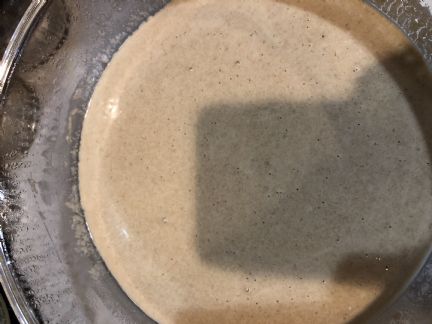
Before rise:
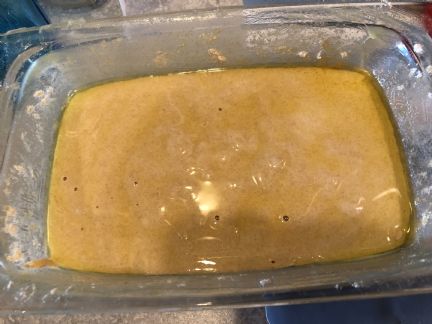
After rise:
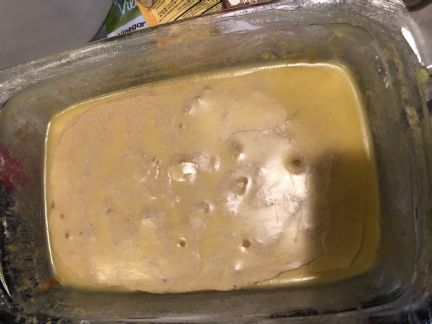
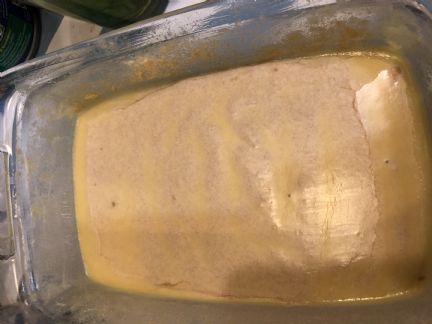
So it looked improved although still not getting to where it should be so I am continuing with the distilled water for this week to see what happens this weekend.
But so after some more research I found that if I did use a more alkaline water it may kill both the lacto and the yeast because neither is meant to be in alkaline environments thats why so many people now are on the alkaline kick because it kills all those things in your body. So the question does seem to be as you posed it, how can I balance them back out? Are there any other ideas besides the water? Can I add honey or something to it since yeasts seem to love sugar and breaking it down? Or does that form alcohol somehow? There has to be a way to help the yeast kick back the lacto. Any other suggestions Id be happy to try.
Thanks
Jay |
 |
|
|
Back2theroots
10 Posts
Jay
St. Petersburg
Florida
USA
|
 Posted - May 09 2019 : 05:51:00 AM Posted - May 09 2019 : 05:51:00 AM


|
| I actually had another thought last night since you mentioned that lacto fermenting might be affecting it. What if I take some mother out and place it in a glass with some water and sugar to yeast ferment right next to my mother? Not for consumption but just to attract more yeast to the mother? |
 |
|
|
Ashley
656 Posts
Ashley
MOSCOW
Idaho
USA
|
 Posted - May 09 2019 : 09:03:33 AM Posted - May 09 2019 : 09:03:33 AM


|
I think it's promising you saw improvement this week. By adding honey, you wouldn't create alcohol, as this only happens when a ferment is deprived of oxygen. Shying away from additives is best practice. Although adding honey may offer the boost needed for the yeasts to multiply, it could bring about unforeseen issues.
Your idea of removing a bit of mother and and mixing in sugar to place next to your mother as bait could work. Another possibility is to set some grapes next to your mother. Both these options may not yield any results, but I'm of the opinion that it doesn't hurt to try, and you're already invested in getting your mother going, so if it brings in those yeasts you're in need of, it won't hurt. Lastly, this may seem a bit silly, but if you take extra care when stirring to really aerate it, it may help. Just spend a little extra time at each feeding stirring and lifting the spatula up to really circulate your mother. |
Ashley Ogle |
 |
|
|
Back2theroots
10 Posts
Jay
St. Petersburg
Florida
USA
|
 Posted - May 12 2019 : 07:00:47 AM Posted - May 12 2019 : 07:00:47 AM


|
I actually read about stirring and aerating more in this thread somewhere and have been doing this. Ill try to just do even more of it. Ill try the yeast bait and see if it helps. I just don’t see that much improvement week to week as I expect. Ill keep trying, but yes at this point I am too invested to want to start over.
This weeks bread still didn’t rise much more. So I am not seeing what I expect but does not mean its not the right track I suppose.
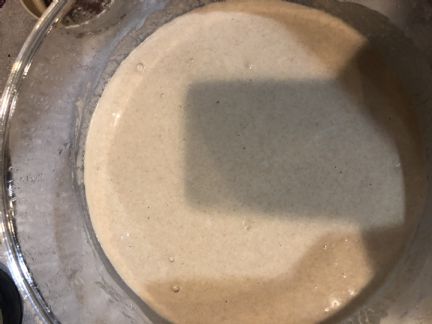
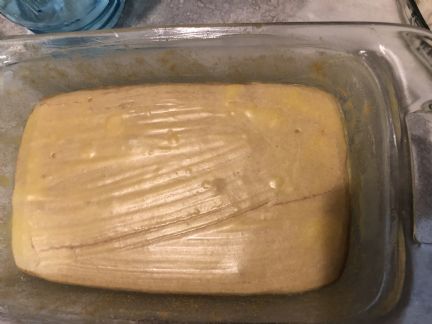
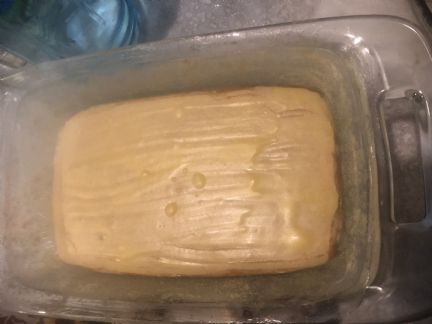 |
 |
|
|
Ashley
656 Posts
Ashley
MOSCOW
Idaho
USA
|
 Posted - May 13 2019 : 09:25:54 AM Posted - May 13 2019 : 09:25:54 AM


|
| You should be seeing more happening than this by now. You've been keeping your mother for 7 weeks or so, right? When you go to stir your mother at each feeding, do you ever have a layer of water on the top? |
Ashley Ogle |
 |
|
|
Back2theroots
10 Posts
Jay
St. Petersburg
Florida
USA
|
 Posted - May 13 2019 : 12:36:33 PM Posted - May 13 2019 : 12:36:33 PM


|
No never had that, some days even though the towel is moist covering it, it looks dry and there is virtually no activity bubble wise I tend to just add more water then usual and then the next feeding there is bubble activity again. So if anything its dry occasionally.
Yes I have been keeping it for 8 weeks now. I switched the water again now to try something different. Switched to Purified water that is treated by "Deionization,Micron Filtration (Microfiltration), Ozonation,Ultraviolet (UV) Light". See what comes of this. Says it has a PH range from 5-7. |
 |
|
|
Ashley
656 Posts
Ashley
MOSCOW
Idaho
USA
|
 Posted - May 14 2019 : 08:38:33 AM Posted - May 14 2019 : 08:38:33 AM


|
Hmm, it's interesting that when it's a tad dry and you add a little extra water it perks up and you see activity. I wonder if this could be the ticket? Are you keeping your bowl of mother inside a larger dish filled with water? Einka is a thicker mother--I'd say the consistency of ours is a little thinner than thick pancake batter. If you dip a spatula in the mother and lift in a scooping motion, some mother will stick to the spatula, but most will fall away. If water is evaporating from your mother, maybe adding a little extra will give it a boost?
The main reason I asked about the water on the surface is because we've talked about your mother being overly acidic. If you had a bit of separation, you could test the water with a pH strip, and it might provide a clue as to what's happening, but if you've never seen separation, this wouldn't work. |
Ashley Ogle |
 |
|
|
Back2theroots
10 Posts
Jay
St. Petersburg
Florida
USA
|
 Posted - May 14 2019 : 09:18:00 AM Posted - May 14 2019 : 09:18:00 AM


|
Oh yes definitely follow the directions in the book. Keep a baking dish the bowl sits in, fill with water, and then cover with the flour sack cloth tucking it into the water so it wicks up. So thats always moist. Sometimes the towel seems to loose its wicking ability though but thats when I change to the next one. I bought all the recommended things from the book to make sure I don’t add any weird factors to the mix.
Thats kind of the consistency I go for and did read in the flour section of the book that einkorn is a little slower at absorbing the water so I also wait a little to make sure the consistency doesn’t really change. So do tend to try to keep it on the thin side. It also is a little clumpy sometimes which is weird to me because when I go to make the beginner batter there is never clumps and its a whole lot more flour to water ratio so Id expect more clumping. But the clumps usually resolve themselves by next feeding. So maybe its just the clump ratio that sometimes causes it to dry out a little as there are more that I dont fully break up. But I do try to pay close attention to that. How much water do you use? I tend to be between 1/4 and 1/3 somewhere. And sometimes when I feel it needs more and is to thick I add a little splash. |
 |
|
|
Back2theroots
10 Posts
Jay
St. Petersburg
Florida
USA
|
 Posted - May 14 2019 : 5:41:47 PM Posted - May 14 2019 : 5:41:47 PM


|
| See the consistency descriptions is what get me. For example I have no idea what thick pancake batter even is like because I follow the gaps diet on most things this is pretty much a treat for me. My pancakes are made from banana, nut butter, and eggs. So Im sure thats a little different then typical flour pancake batter. So I need to figure out how to put some short videos on here to show the consistency I have because even the “softened cream cheese” consistency has me scratching my head because there are so many kinds of cream cheese and some end up being much thicker then others when soft. I don't really use Philadelphia which is what my guess is this would be based on. Either way thats the hardest part for me to get reference to is the consistency. Even the spoon reference you provided is making me ask more questions. Its always best to see with your own eyes at least for me. Visual learner I guess. |
 |
|
|
Ashley
656 Posts
Ashley
MOSCOW
Idaho
USA
|
 Posted - May 15 2019 : 10:23:53 AM Posted - May 15 2019 : 10:23:53 AM


|
I grappled with the language I used to describe the consistency, that's why I tend to default to comparisons. I did feed our Refrigerator mothers this morning and snapped a couple pictures of the Einka one. Since it's cold, the consistency may look slightly thicker than one being kept at room temperature, but the two should be pretty close.
Here is what it looked like fresh from the refrigerator before any stirring or feeding:

Note the dry looking top? Is this similar to what your Counter mother looks like at each feeding? The top isn't really any thicker than the rest of the mother--it stirs back in without becoming clumpy.
Here's a picture that shows a bit of the texture:

It kind of glops off the spatula, and in the loaf pan, you can see the bits that have fallen from the spatula retain definition for a little while before settling.
And this was taken about 30 seconds after I finished stirring it. Already, you can see bubbles (more visible in person than through the lens, but you can see a couple).
 |
Ashley Ogle |
 |
|
|
Back2theroots
10 Posts
Jay
St. Petersburg
Florida
USA
|
 Posted - May 24 2019 : 7:08:17 PM Posted - May 24 2019 : 7:08:17 PM


|
| Yes that is about the dryness I was seeing. Mine is still a counter mother so I don’t know how different the texture should be but mine is much much thinner then that. But since the change of water the purified water with the higher ph I seem to have much more bubbles during feeding but now you make me wonder if I keep it too thin. That seems really thick to me. Can it being too thin be causing my issues? Do I need to get it thicker? Ill try to take some pictures tomorrow before I bake to show you the thickness. |
 |
|
|
Ashley
656 Posts
Ashley
MOSCOW
Idaho
USA
|
 Posted - May 28 2019 : 08:30:14 AM Posted - May 28 2019 : 08:30:14 AM


|
| If your mother is really thin to the point of being watery, it could be problematic. If you're able to put some pictures up, that would be great. You said you're using Bluebird Grain Farms Einka, are you buying the flour milled or are you milling your own? And you're feeding your mother 3/8 cup flour and 1/4 water at each feeding? That's great news that you're seeing more bubbles with your most recent water switch! |
Ashley Ogle |
 |
|
|
NancyOH1
6 Posts
Nancy
Columbus
OH
USA
|
 Posted - Feb 22 2020 : 12:00:11 PM Posted - Feb 22 2020 : 12:00:11 PM


|
| I am so glad I cam to read through this topic of starting my mother. I wish I had taken pictures to post. I started my initial mother a few weeks ago (approximately 3 to 4). My mother never seemed to thicken up correctly even with the anticipated layer of water on top prior to feeding and stirring the next feeding. It was always thin and very water. This morning I restarted a new mother once I figured out what the problem was with the first batch. The actual coffee scoop I was using for the flour wasn't actually 1/8 per scoop. I have a measuring cup that I had purchased from Bed Bath and Beyond with 1/8 cup marked on it and used the scoop I was using to see actually how much it held. Well it the scoop was not a full 1/8 cup it was about half. Once I measured out the first feeding of both flour and water I could tell the difference in the batter once I mixed it together with the spatula. |
Nancy J. Noble |
 |
|
| |
Topic |
|